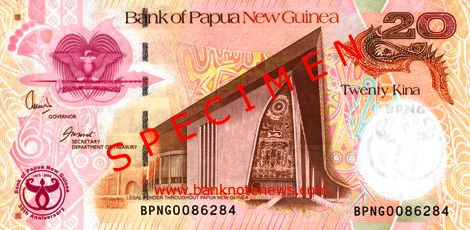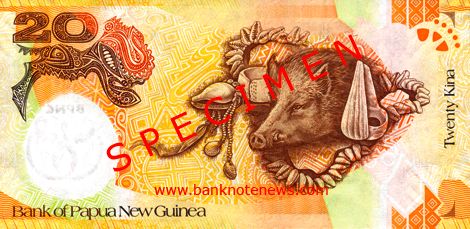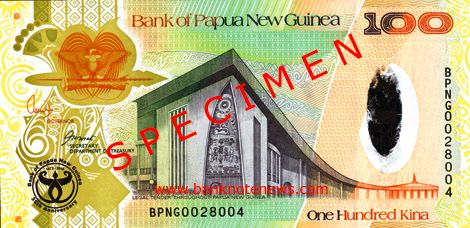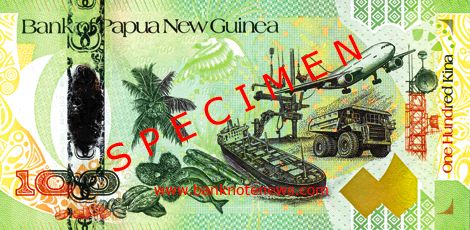Papua New Guinea issues commemorative 20- and 100-kina notes
27 04, 2009 07:39 Category: East and Southeast Asia | Commemorative
On April 22, 2009, the governor of the Bank of Papua New Guinea, Wilson Kamit, gave the following speech concerning the issue of commemorative 20-kina and 100-kina banknotes, which became legal tender the following day:
“Members of the Board, invited guests, staff and management of the Bank of PNG, media representatives, ladies and gentlemen, welcome to the release of the our new K20 and K100 paper banknotes commemorating the 2009 KINA & TOEA DAY which is on 19 April 2009. This day unfortunately falls on the weekend this year so we decided to celebrate it today.
Ladies and gentlemen, when we introduced our own currency in 1975, it was one of the many steps of nation building, just like introducing our own national flag, national anthem and international institutions such as the Bank of PNG. The first issue of banknotes was in three denominations, namely the 2 Kina, 5 Kina and 10 Kina notes. The 20 Kina banknote was introduced three years later in 1978, followed by the 50 Kina banknote in 1989 and the 100 Kina note in 2005. Initially, apart from the 100 Kina banknote, all these denominations were in paper substrate.
Our currency has evolved over the 34 years, keeping abreast of the growth and development of the country, the monetization within the economy, changes in the technology of producing currency and the economics (cost) of producing coins and banknotes. You would no doubt have noticed that we have converted our banknotes from paper to polymer substrate as a result of advancement in security and technologies for printing banknotes. This however does not stop us from issuing paper banknotes as well because the technology for paper substrate has evolved with advanced security features as we shall see on our new K100 banknote.
In 2005 we commenced a review of our family of currency. The Bank introduced the K100 as the highest denomination in the family of banknotes, and reduced the size of the K1 coin. The larger sized K1 coin is being gradually withdrawn from circulation. We also demonetized the one and two toea copper coins. Last year, we introduced the new K2 coin which is being used alongside the K2 banknote. Given the frequent usage with the resultant wear and tear of the K2 banknote, we will assess the usage of the K2 coin before deciding on its future.
For the banknotes, we standardized the main theme on all the new series to show the National Parliament House on the front which emphasized Nation building and Nationhood. The images of the Parliament House on each of the banknotes are taken at different angles to make each note unique and different. On the back of the notes, we retained the original designs of traditional forms of money used in different parts of Papua New Guinea.
There are advanced security features incorporated in all these new series of banknotes to protect against counterfeiting. To date, we have not experience any major counterfeiting in our banknotes but it is worthy to take preventive action than to be sorry after.
As I have mentioned during previous releases of our various currencies, Papua New Guinea is predominantly a cash-based economy, where the majority of our people continue to use cash (coins and banknotes) as the main form of payment in settling their transactions. We will therefore ensure an acceptable quality of banknotes with longevity, given our humid, tropical climate and the frequent and rough handling of currency by the public.
The Bank has engaged De La Rue Currency to produce these two commemorative paper banknotes. As a risk management strategy, we have the option to use them should the supplier of our polymer (plastic) banknotes be unable to produce our banknotes. De La Rue has developed a more advanced security feature called the Optiks security thread, which can be seen through the aperture at the front of the new K100 note, making it difficult to produce counterfeits. It is also prudent to have an alternative supplier so that we can optimize on the price quality and swiftness of delivery of orders from our suppliers.”


20 kina (US$7.60)
Red-brown. Front: 35th anniversary logo; coat of arms with bird of paradise perched on Kundu drum and ceremonial spear; National Parliament building in Port Moresby. Back: boar head; toea (cowrie shell) necklace from Madang; Toa armband from Central Province; shell ornament from Western Province; tapa cloth patterns. Windowed security thread with demetalized BPNG. Watermark: Bank logo, electrotype BPNG, and Cornerstones. Printer: TDLR (w/o imprint). 150 x 75 mm. No date. Signature 11. Introduced 04.23.2009.


100 kina (US$38)
Green and gold. Front: 35th anniversary logo; coat of arms with bird of paradise perched on Kundu drum and ceremonial spear; National Parliament building in Port Moresby. Back: Palm tree; cowrie shells; fish; timber; cargo ship; oil rig; bird; jumbo jet; dump truck; microwave tower. Optiks security thread with demetalized BPNG 100. Watermark: Bank logo and Cornerstones. Printer: TDLR (w/o imprint). 150 x 75 mm. No date. Signature 11. Introduced 04.23.2009.
Courtesy of Don Cleveland and Thomas Krause.
“Members of the Board, invited guests, staff and management of the Bank of PNG, media representatives, ladies and gentlemen, welcome to the release of the our new K20 and K100 paper banknotes commemorating the 2009 KINA & TOEA DAY which is on 19 April 2009. This day unfortunately falls on the weekend this year so we decided to celebrate it today.
Ladies and gentlemen, when we introduced our own currency in 1975, it was one of the many steps of nation building, just like introducing our own national flag, national anthem and international institutions such as the Bank of PNG. The first issue of banknotes was in three denominations, namely the 2 Kina, 5 Kina and 10 Kina notes. The 20 Kina banknote was introduced three years later in 1978, followed by the 50 Kina banknote in 1989 and the 100 Kina note in 2005. Initially, apart from the 100 Kina banknote, all these denominations were in paper substrate.
Our currency has evolved over the 34 years, keeping abreast of the growth and development of the country, the monetization within the economy, changes in the technology of producing currency and the economics (cost) of producing coins and banknotes. You would no doubt have noticed that we have converted our banknotes from paper to polymer substrate as a result of advancement in security and technologies for printing banknotes. This however does not stop us from issuing paper banknotes as well because the technology for paper substrate has evolved with advanced security features as we shall see on our new K100 banknote.
In 2005 we commenced a review of our family of currency. The Bank introduced the K100 as the highest denomination in the family of banknotes, and reduced the size of the K1 coin. The larger sized K1 coin is being gradually withdrawn from circulation. We also demonetized the one and two toea copper coins. Last year, we introduced the new K2 coin which is being used alongside the K2 banknote. Given the frequent usage with the resultant wear and tear of the K2 banknote, we will assess the usage of the K2 coin before deciding on its future.
For the banknotes, we standardized the main theme on all the new series to show the National Parliament House on the front which emphasized Nation building and Nationhood. The images of the Parliament House on each of the banknotes are taken at different angles to make each note unique and different. On the back of the notes, we retained the original designs of traditional forms of money used in different parts of Papua New Guinea.
There are advanced security features incorporated in all these new series of banknotes to protect against counterfeiting. To date, we have not experience any major counterfeiting in our banknotes but it is worthy to take preventive action than to be sorry after.
As I have mentioned during previous releases of our various currencies, Papua New Guinea is predominantly a cash-based economy, where the majority of our people continue to use cash (coins and banknotes) as the main form of payment in settling their transactions. We will therefore ensure an acceptable quality of banknotes with longevity, given our humid, tropical climate and the frequent and rough handling of currency by the public.
The Bank has engaged De La Rue Currency to produce these two commemorative paper banknotes. As a risk management strategy, we have the option to use them should the supplier of our polymer (plastic) banknotes be unable to produce our banknotes. De La Rue has developed a more advanced security feature called the Optiks security thread, which can be seen through the aperture at the front of the new K100 note, making it difficult to produce counterfeits. It is also prudent to have an alternative supplier so that we can optimize on the price quality and swiftness of delivery of orders from our suppliers.”


20 kina (US$7.60)
Red-brown. Front: 35th anniversary logo; coat of arms with bird of paradise perched on Kundu drum and ceremonial spear; National Parliament building in Port Moresby. Back: boar head; toea (cowrie shell) necklace from Madang; Toa armband from Central Province; shell ornament from Western Province; tapa cloth patterns. Windowed security thread with demetalized BPNG. Watermark: Bank logo, electrotype BPNG, and Cornerstones. Printer: TDLR (w/o imprint). 150 x 75 mm. No date. Signature 11. Introduced 04.23.2009.


100 kina (US$38)
Green and gold. Front: 35th anniversary logo; coat of arms with bird of paradise perched on Kundu drum and ceremonial spear; National Parliament building in Port Moresby. Back: Palm tree; cowrie shells; fish; timber; cargo ship; oil rig; bird; jumbo jet; dump truck; microwave tower. Optiks security thread with demetalized BPNG 100. Watermark: Bank logo and Cornerstones. Printer: TDLR (w/o imprint). 150 x 75 mm. No date. Signature 11. Introduced 04.23.2009.
Courtesy of Don Cleveland and Thomas Krause.

